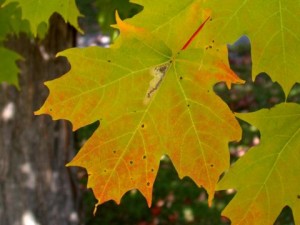Acer saccharum is a species of maple native to the hardwood forests of eastern Canada, from Nova Scotia west through Quebec and southern Ontario to southeastern Manitoba around Lake of the Woods, and the eastern United States, from Minnesota to Georgia and Texas. Sugar maple is best known for its bright fall foliage and for being the primary source of maple syrup.
Contents
Uses
The sugar maple is one of the most important Canadian trees, being, with the black maple, the major source of sap for making maple syrup. Other maple species can be used as a sap source for maple syrup, but some have lower sugar contents and/or produce more cloudy syrup than these two. Some other trees (birch, ash, etc.) can yield a useful syrup as well, though with different flavors. In maple syrup production from Acer saccharum, the sap is extracted from the trees using tap placed into a hole drilled through the phloem, just inside the bark. The collected sap is then boiled. As the sap boils, the water is evaporated off and the syrup left behind. 40 litres of maple sap are required to be boiled to produce only 1 litre of pure syrup. This is the reason for the high cost of pure maple syrup.
Benefits
- A tea made from the inner bark is a blood tonic, diuretic and expectorant. It has been used in the treatment of coughs, diarrhoea etc. A compound infusion of the bark has been used as drops in treating blindness. The sap has been used for treating sore eyes. The inner bark has been used as an expectorant and cough remedy. Maple syrup is used in cough syrups and is also said to be a liver tonic and kidney cleanser.
- Considered by many to be the most valuable hardwood tree in N. America, the sugar maple is used for a wide range of applications including furniture, flooring, turnery, musical instruments and ship building. Accidental forms with the grain curled and contorted, known as curly maple and bird’s eye maple, are common and are highly prized in cabinet making. The wood is also a very good fuel, giving off a lot of heat and forming very hot embers. The ashes of the wood are rich in alkali and yield large quantities of potash.
Cautions
To learn more about saccharum side effects, drug interactions or safety concerns, read either the drug label or the drug’s package insert. You may also want to speak with your pharmacist or healthcare provider.
Interactions
None are recorded. Please consult a specialist.
Other names
sugar maple or rock maple
References
Source: Wikipedia, https://en.wikipedia.org/wiki/Acer_saccharum#Cultivation_and_uses
Plants for a Future, http://www.pfaf.org/user/Plant.aspx?LatinName=Acer+saccharum

